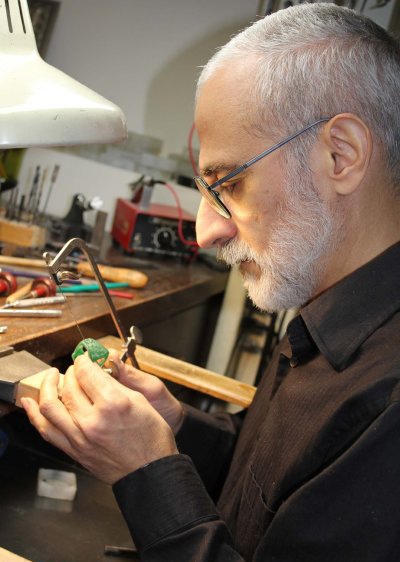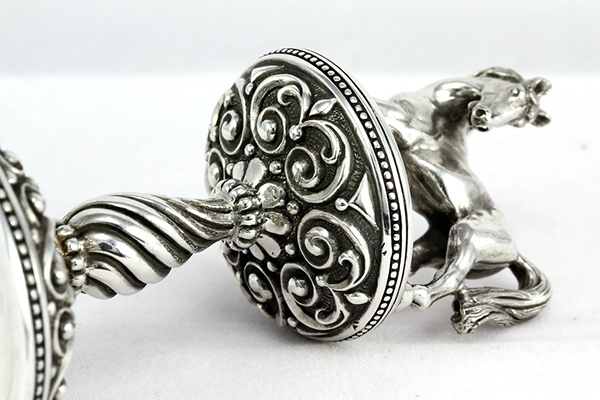Garri Dadyan, A Virtuoso of Metal Work
Tucked in the highlands of the South Caucasus, Armenia, is a land with ancient origins that can be traced back to as early as the Bronze age (about 4,000 BC) or even earlier. In fact, the first known winery in the world is believed to have started in Armenia. A culture filled with legends and influenced by early Greek and Roman cultures, Armenia has embraced Christianity in the early 4th century, and is often referred to as the “first Christian nation.” However, due to its geo-strategic location, this area has never ceased to be a battleground for military conflicts. Although riddled with wars and ruled by different empires over the past centuries, its people have firmly maintained Christianity as their primary religion. Consequently, the metal work of Christianity’s decorative art and weaponry has been important throughout Armenia’s cultural heritage.
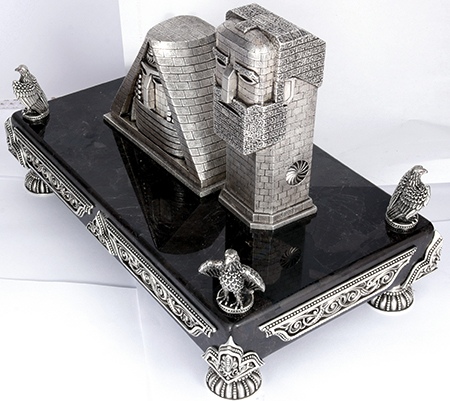
Garri Dadyan, an ethnic Armenian, has revived this ancient metal craftsmanship and brought it to a high level of artistry by combining the use of traditional techniques and modern technology.
Garri started his apprenticeship in metal work with the metal masters in Tbilisi, the center for Repoussé revival. His talents soon gained recognition among the former Soviet Union’s art establishment and earned him its highest award as “Master Artist” in the 1980s. He also became a member of the UNESCO International Federation of Artists in the early 1990s.
Garri’s metal work is not only rich in patterns but also unique in its use of texture and complex design. His fluid use of chasing and repoussé, a technique traced back to ancient Egypt’s decorative metal work for the royals, enchants people with beautiful visual effects on copper, silver, and gold, making each of his works one of a kind. Taking inspiration from nature, his leafy and flowery designs on metal give life to the objects by making use of intertwined and curly patterns showing the poetic beauty of nature and its harmonious elegance.
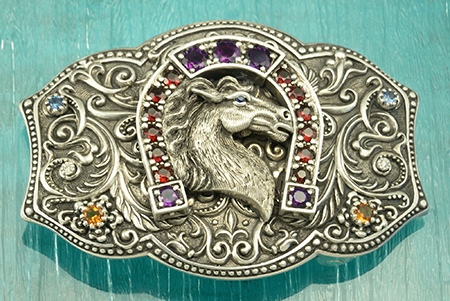
Living in Seattle since the late 1990s, Garri has brought his fine metal craftsmanship to the US. We are very pleased to be able to interview Garri and present to readers a true metal master’s work.
Q: Your metal work is so intricate and beautiful. It takes a real master to create such beautiful jewelry and artwork. Please share with us your training in this field.
A: Thank you! Having been raised in Soviet Azerbaijan in the 1950s and 1960s, I was little exposed to the rich artistic and religious heritage of my historic ethnic Armenian roots. However, at the age of 15, I visited Armenia, and Echmiadzin, the historic heart and capital of the Armenian Apostolic Church, and of Armenian culture. This was to have a lasting impact on me.
I attended the College of Applied Decorative Arts in Baku in 1970-71, where I studied ceramics. Even while pursuing the course in ceramics, I realized that metal was my real interest. Upon completing this course, I entered Soviet military service, and in my second year was called upon to head the ceramics team assigned responsibility for decorating the Central Staff Offices of the Soviet Army’s new Caucasian Division Headquarters in Tbilisi, Georgia.
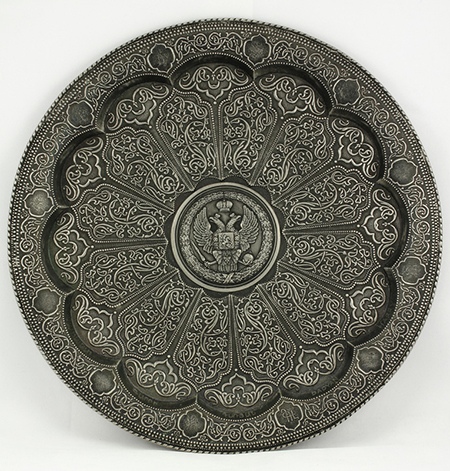
As head of the ceramics team, I worked alongside the members of the decorative metalwork team and enjoyed complete access to their tools and materials. I used the relative freedom of movement and access that my status as ceramics team head afforded me to both pursue my interest in decorative metalwork, and visit the studios of Tbilisi’s acclaimed masters of repoussé. (Tbilisi was at the time the center of the repoussé revival.) I took advantage of the opportunity to study their workmanship and techniques, visiting their studios often, in particular, those of the famed Soviet Georgian sculptor, I. A. Ochauri, a leader in the revival of repoussé. In addition, I visited the museums of Tbilisi in order to study other works of contemporary repoussé masters. I thus engaged myself in a sort of informal apprenticeship to the Tbilisi masters.
Upon returning to Baku a year later in 1974, I determined to do metalwork exclusively, and took a job in a repoussé studio, where I was soon given the title of “Master Artist”, and given the top designation of “6th rank”. Over the next five years, I perfected my mastery of the simple repoussé technique of the period and began to rise in the ranks of the Soviet art establishment. I soon worked exclusively for the Soviet Art Fund, fulfilling their commissions for public works throughout the Soviet Union, and for sale in their galleries.
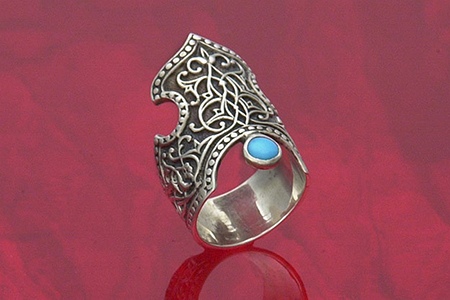
Q: Your dedication to metal work has won you many accolades. For example, you were named a National Master Artist of the (former) Soviet Union in 1985 for your excellent metal work and in 1993 you became a member of the UNESCO International Federation of Artists in recognition of your superior artistry. Please tell us what sets you apart from other metal artists that allowed you to reach such high esteem.
A: I have taken the traditional methods of casting and chiseling and developed them to more intricate and sophisticated levels than had previously existed in Caucasian weaponry and ancient Armenian art. By using these in combination with the electro-chemical process of galvanization, I have achieved a level of technical and artistic sophistication rarely seen in the Eastern and modern art of decorative metalwork. What sets me apart is that I continue to innovate new technologies in metalwork to this day and never stop creating new techniques.
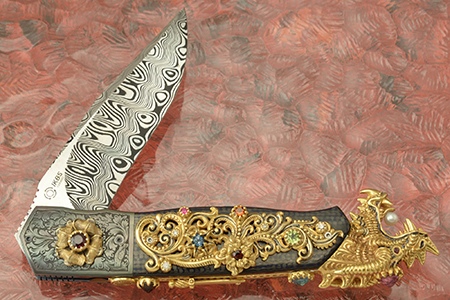
As for my designs, they are exclusive designs, unless a custom order requires specific design desired by the client. My works have been exhibited extensively in the Soviet and then Russian Artists’ Union Galleries, including in the annual Artists’ Union exhibits in the exclusive Manezh Exhibition Hall on Manezh Square in central Moscow. Exhibits in Western Europe and Mexico featured my work through the 1980s and 1990s. My artwork can also be seen in numerous venues and museums throughout the former Soviet Union, including a majority of the foreign embassies in Moscow. I have fulfilled numerous private commissions for high-level government officials in the Kremlin, for Soviet and Russian military officers and individuals. My work has also been featured in an art museum in Washington state, as well as numerous art shows, which I received awards for.

Q: Each piece of your artwork is so complex, filled with motifs ranging from mythology, legend, and the Bible. Please share with us your main source of inspiration that supplies you with so many artistic design ideas.
A: My ideas are inspired by nature, ancient art, and sculptures. I love using sculpture technology in jewelry and knife making.
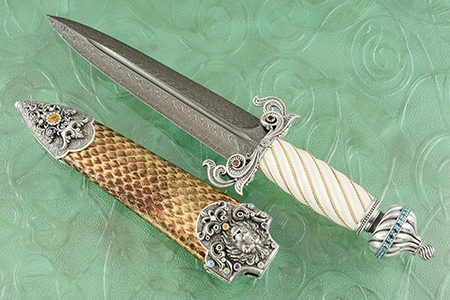
Q: Your work on knives is extremely beautiful. Please tell us how many hours you typically spend working on one knife and what aspects you consider when you design a knife and how you work on the blades.
A: It’s difficult to count the hours when creating an art piece, and I never timed myself. As an artist, I find it incorrect to consider the clock, as each piece is truly a work of art. For example, if I receive an order for a custom knife, it might be at least a month of work, or more, depending on complexity. There is a famous saying in Russian that says “People in love do not notice the clock”, same should apply to artists, we do not notice the clock. Reason of timing one’s work would be purely financial, and that is not an aspect that should be considered by a true artist.
When I create a knife I consider all modern and ancient aspects of knife design, utilizing my own techniques. As for blades, I either custom order them from world-famous blade makers, such as Andre Thorburn, or fabricate them myself, using the appropriate blade-making techniques.

Q: What materials and techniques do you employ in your metal work?
A: Repoussé is performed by taking a thin sheet of metal and chasing a design or image on it from both sides. When the metal is worked from one side only it is called chasing. Fine liners (chisels) and delicate hammers are used to chase the metal from the front, and punches (blunt-nosed chisels) are used to work it from the back, creating the design in relief.
In order to facilitate creating “volume”, or the protruding parts of the relief, I employ resin, clay, wax, iron, sand, etc., to “cushion” the metal while I chase and punch it.
As a master metalsmith, I use repoussé, engraving, filigree and granulation, niello, wax-casting and enamel with equal dexterity and mastery, frequently employing them in combination, depending on the effect I wish to produce.
I use electro-forming to produce reproductions of entire repoussé originals, and also sometimes use it in combination with repoussé to create the original form, depending on the effect I wish to achieve. In this case, I begin with repoussé, creating a negative, then use electro-forming to create a positive, which I continue to chase back and forth, from one to ten times depending on the intricacy of the design. At present, I am not aware of anyone else in the world using electro-forming in this manner. These techniques are best demonstrated to be fully understood, as they are subject to misunderstanding due to the traditional uses of electro-forming.
I work with solid copper for my repousse creations and with sterling silver and gold with precious stones for my jewelry and knife creations.
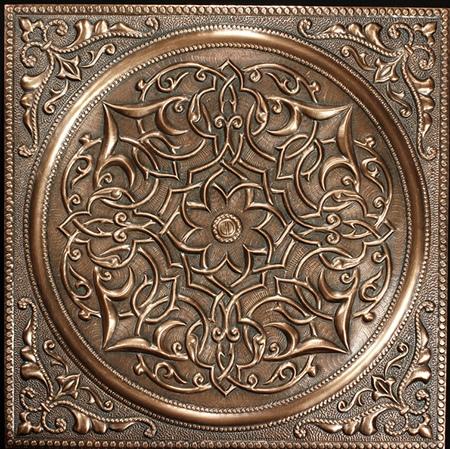
Q: What is Cheknaka? How have you transformed the look and use of metal works that are used in the modern era?
A: “Chekanka” is chiseled metalwork, which figures prominently in religious and military artistry throughout the Caucasus. I have taken the traditional methods of casting and chiseling and developed them into more intricate and sophisticated levels than had previously existed in Caucasian weaponry and ancient Armenian church art. By using these in combination with the electro-chemical process of galvanization, I have achieved a level of technical and artistic sophistication rarely seen in the Eastern art of decorative metalwork.
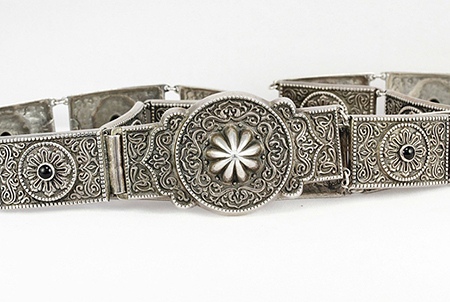
Q: What is your advice to the beginners who want to perfect their skills in the metal work?
A: While creating artwork, I advise thinking about creating a fine quality art as main incentive, and not to think about financial gain, or business, as motivators.
Q: Where is the best place to purchase your products?
A: Because most of my work is custom ordered, the best place to purchase is by sending an inquiry to info@melicdadayan.com, or through direct messages from my Instagram account @melicdadayan. Instagram is the best place to see updates and all-new available products. Almost everything in the Gallery tab on my website (melicdadayan.com) is available for a custom order.
